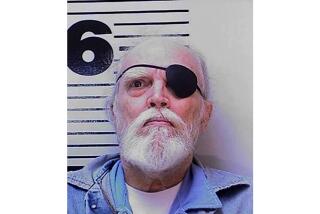‘Grim Sleeper’ serial killer Lonnie Franklin dies on death row at San Quentin

Lonnie David Franklin Jr., the so-called Grim Sleeper serial killer who preyed on Los Angeles women for more than two decades, died Saturday while on death row at San Quentin prison, officials said.
“Franklin was found unresponsive in his single cell on March 28 at about 7:20 p.m. Medical assistance was rendered and an ambulance was summoned. Franklin was pronounced deceased at 7:43 p.m. His cause of death is pending the results of an autopsy; however, there were no signs of trauma,” prison officials said in a statement.
Franklin, 67, was convicted in 2016 of killing nine women and a teenage girl from 1985 to 2007. During the penalty phase of his trial, prosecutors connected him to several additional slayings. Detectives believe he may have killed at least 25 women.
The killer, one of California’s most prolific, targeted victims who were generally young, vulnerable and, at times, ignored. The attacks failed to raise alarms the way other famous serial slayings by killers such as the Hillside Strangler or the Night Stalker did.
The deaths in the mid- to late ’80s coincided with a surge in slayings linked to the crack cocaine epidemic. In addition, several other serial killers were operating in the same area in those years. Michael Hughes was convicted of killing seven women; Chester Turner of 14 women and a fetus. Both are on California’s death row.
But the Grim Sleeper proved to be the most persistent. He targeted women who were drug addicts or prostitutes and often dumped their naked bodies alongside roads or in the trash. Many of the women were initially listed as Jane Does. The deaths drew little, if any, media attention.
Police kept the slayings quiet despite suspicions that a serial killer was stalking black women — a decision that led to outrage and condemnation from many who attribute Franklin’s longevity as a killer to police indifference.
Authorities were able to link the slayings through ballistic and genetic evidence at the crime scenes that pointed to a single killer. But identifying the DNA proved difficult.
A break finally came in the case in 2010, when a search of state offender records turned up a partial match. The person wasn’t the suspected serial killer, but a close relative was.
Before long, investigators focused on the convict’s father, Franklin. After tailing him to a pizza joint in Buena Park during the summer of 2010, police collected a slice of partially eaten pizza. They tested it for DNA and, finally, had a match.
Franklin’s defense attorney during his trial, Seymour Amster, released a statement Sunday regarding the killer’s death. He criticized prosecutors’ choice to seek the death penalty against his late client and suggested those resources would have been better “utilized to uplift young girls of color like Franklin’s victims.”
But, he said, “As Lonnie Franklin’s attorney, I completely respect the jury’s determination that he was guilty of the most heinous crimes. And to the victims’ families, I sincerely hope that the end of Franklin’s life brings some peace into theirs.”
Franklin’s death while awaiting execution is not unusual for California’s condemned inmates. Only 13 inmates have been executed in the state since capital punishment was reinstituted in 1978, with dozens of others dying of natural causes or suicide; in some cases, including Franklin’s, the cause of death remains under investigation.
There are 727 inmates currently on death row.
More to Read
Sign up for Essential California
The most important California stories and recommendations in your inbox every morning.
You may occasionally receive promotional content from the Los Angeles Times.











